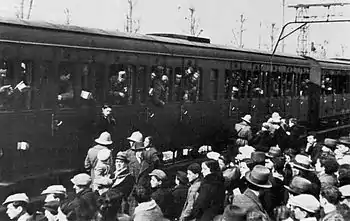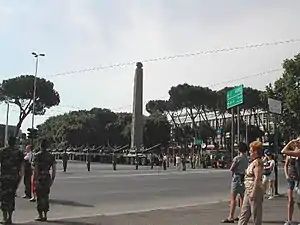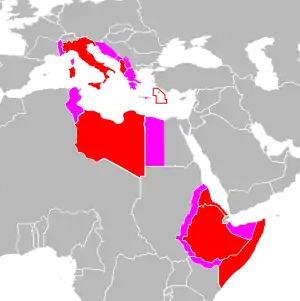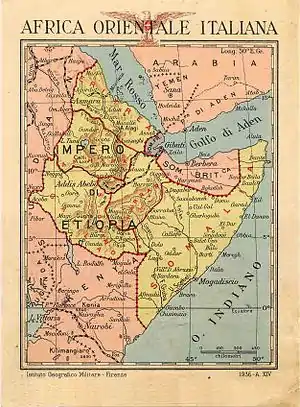Italians of Ethiopia
Italians of Ethiopia are the immigrants from Italy who moved to live in Ethiopia as far back as the 19th century, and their descendants. King Menelik II did not allow the sale of lands belonging to Ethiopia to Italians (Eritrea) and probably allowed France (Djibouti) to solidify his centralized power and have external trading partners. Most of the Italians moved to Ethiopia after the Italian conquest of Abyssinia in 1936. Italian Ethiopia was made of Harrar, Galla-Sidamo, Amhara and Scioa Governorates in summer 1936 and became a part of the Italian colony Italian East Africa, with capital Addis Abeba[1] and with Victor Emmanuel III proclaiming himself Emperor of Ethiopia.
 Italian soldiers leaving for Ethiopia in 1935 | |
| Total population | |
|---|---|
| 1,400 (plus 2,000 descendants) | |
| Regions with significant populations | |
| Addis Ababa | |
| Languages | |
| Italian, Amharic | |
| Religion | |
| Christian, mostly Roman Catholic | |
| Related ethnic groups | |
| Italians |
History
The 1880s were marked by the so-called "Scramble for Africa" and the Berlin Conference of 1884–85. When the Italians began to vie with the British and French for influence in the area. Asseb, a port near the southern entrance of the Red Sea, was bought by in March 1870 from the local Afar sultan, vassal to the Ethiopian Emperor, by an Italian company, which by 1890 led to the Italian colony of Eritrea being established. From then on, the Kingdom of Italy had traded and set up large tracts of farm land up to the borders with Ethiopia. As the Italian colonists moved further inland from the agreed upon borders of Eritrea which had been agreed upon in the Treaty of Wuchale, Emperor Menelik II saw this as an invasion of his country, whereas the Italian King Umberto of Italy referred to Article 17 of the treaty to justify Italian claims to the land.
Conflicts between the two countries resulted in the Battle of Adwa in 1896, whereby the Ethiopians defeated Italy and remained independent, under the rule of Menelik II. At the time, Italy had only been unified for less than a few decades, and support for the war was minimal, especially among Southern Italians who were forcibly conscripted. Anti-war riots and demonstrations broke out across Italy and in the city of Pavia the population came out to blockade the railroad to prevent Italian troops from leaving for Ethiopia. Many Italian prisoners of war were treated very well, and many given over to noble families for work on their estates, while others with specialized skills were used in the construction of the newly formed capital of Addis Ababa, such as St George's Cathedral. Italy and Ethiopia signed a provisional treaty of peace on 26 October 1896.
Shortly after the Fascist government under Benito Mussolini forcibly came to power, he began a campaign to expand the African colonial possessions of Italy in the 1930s. In October 1935, Mussolini launched the Second Italo-Abyssinian War and invaded Ethiopia. Emperor Haile Selassie went exile to avert the genocide in the hands of Italians in war and appeal to the society of the nations the Ethiopian capital of Addis Ababa on 2 May 1936 and the Fascists entered the city on 5 May, after several bloody battles which included the Fascist army's use of mustard gas[2] in battle against the Geneva Protocol[3] of 1929 (of which Italy was a signatory).
Victory was announced on 9 May 1936 and Mussolini declared the creation of the "Italian Empire". The Italians merged Eritrea, Italian Somalia, and newly occupation Ethiopia into Italian East Africa (Africa Orientale Italiana, A.O.I.). Among the war crimes committed under the orders of Mussolini was the robbing of one of the so-called Axum Obelisks[4](properly termed a 'stele' or, in the local Afro-Asiatic languages, hawelt/hawelti as its form is not topped by a pyramid).
The Italian King Victor Emmanuel III added Emperor of Ethiopia to his titles, a title not welcomed by the many nations that were part of the society of the nations.[5]
From 1936 to the start of World War II Mussolini controlled much of Ethiopia, but a guerrilla war raged in areas of Ethiopia still controlled by resistance ethiopian linked to Haile Selassie (who was exiled in Great Britain) and the royal family remaining in Ethiopia, including the efforts of Ras Imru Haile Selassie who was captured on December 19, 1936 and taken to prison on the Island of Ponza until freed after the Armistice of Cassibile[6]
During Italian occupation
According to official statistics of the Italian government, in October 1939 the Italian Ethiopians were 35,441, of whom 30,232 male (85.3%) and 5,209 female (14.7%), most of them living in urban areas.[7]
Only 3,200 Italian farmers moved to colonize farm areas, mainly because of the danger of Ethiopian guerrilla (still controlling nearly 1/4 of Ethiopia highlands as of 1940).[8]
Ethiopia (divided between the administrative provinces of Scioa, Oromo, Sidamo, Harar, and Amara) was part of the Italian Empire from 1936 to 1941. The Italians constructed huge and expensive infrastructure projects, that drained the Italian economy but reduced in those years the unemployment in the Kingdom of Italy. They did 18,794 km (11,678 mi) of new roads asphalted: in 1940 Addis Ababa was connected by state-of-the-art roads to Asmara and Mogadishu called Via dell'Impero.
Furthermore, 900 km (559 mi) of railways were reconstructed or initiated/planned (like the railway between Addis Abeba and Assab), dams and hydroelectric plants were built, and many public and private companies were established in the underdeveloped country. The most important were: "Compagnie per il cotone d'Etiopia" (Cotton industry); "Compagnia etiopica del latte e derivati" (Milk industry); "Cementerie d'Etiopia" (Cement industry); "Compagnia etiopica mineraria" (Minerals industry); "Impresse electriche d'Etiopia" (Electricity industry); "Compagnia etiopica degli esplosivi" (Armament industry); "Industria per la birra dell'AOI" (Beer industry); "Trasporti automobilistici (Citao)" (Mechanic & Transport industry).
There was an urban project for the enlargement of Addis Ababa, but these architectural plans -like all the other developments- were stopped by World War II.[9]
After World War II
After WWII, the Italian Ethiopians were given a full pardon by the newly returned Emperor Haile Selassie, as he saw the opportunity to continue the modernization efforts of the country.[10] He declared that no reprisals would be taken against the Italians, and many remained for decades, until the overthrow of the Emperor in the Ethiopian Civil War in 1974. Nearly 22,000 Italo-Ethiopians took refuge in Italy during the 1970s.[10] Their main organization in Italy is the Associazione Italiana Profughi dall'Etiopia ed Eritrea (A.I.P.E.E.).[11]
In recent years, some Italian companies have returned to operate in Ethiopia, and a large number of Italian technicians and managers arrived with their families, residing mainly in the metropolitan area of the capital.[12]
Contemporary relations

In the mid-1990s despite a previous arrangement with the Dergue regime under Menghistu in the 1970s to cede the Obelisk of Axum to Italy in exchange for medical facilities and forgiving an accumulated debt to the Italian government, a populist movement made up of Italians and Ethiopians (both in country and expatriates around the world) began to petition the then current Italian government to return the obelisk,[13] an event which eventually culminated in its repatriation in 2005 to Axum, the city of its creation.[14]
Ethiopia has the largest concentration of Italian schools and cultural institutes in Africa (such as the Scuola Statale Italiana of Addis Abeba), which foster and promote Italian and Ethiopian culture and are free to the public[15] The Italian firm Salini Costruttori[16] was chosen by the Ethiopian government to design and build the Millennium or Renaissance Dam on the Blue Nile river which when completed will be the largest dam and hydroelectric plant in Africa. As the Italian engineers had helped to build the first railway from Addis to Djibouti in the past, the Ethiopian government has contracted them again to expand the railroad network along with India and China.[17] For the last 20 years Italy has continued to be among the top 5 trading partners with Ethiopia and a major investor in the Ethiopian economy.[18]
Notable immigrants
- Luciano Violante, judge and politician
- Luciano Vassallo, Ethiopian footballer and coach of Eritrean and Italian origin
- Italo Vassallo, footballer of Ethiopia national team
- Carla Maria Puccini, actress
- Gabriella Ghermandi, writer and singer
See also
- Italian Ethiopia
- Italian Empire
- Italian East Africa
- History of Ethiopia
- Addis Abeba under Italian rule
Notes
- Italian Addis Abeba
- Metaferia, Getachew (2009). Ethiopia and the United States: History, Diplomacy, and Analysis. Algora Publishing. ISBN 9780875866475.
- "WMD – UNODA". www.un.org. Retrieved 2018-04-10.
- "To Rome and back: The return of an obelisk", Lena Blosat, 2005
- Detailed map of Italian Ethiopia in 1936 (click to enlarge)
- "HyperWar: US Army in WWII: Sicily and the Surrender of Italy [Chapter 29]". www.ibiblio.org. Retrieved 2018-04-10.
- Italian emigration to Ethiopia in the 1930s (in Italian)
- Addis Abeba's 1939 Architectural plan Archived 2011-07-22 at the Wayback Machine
- Photos and articles of Italoethiopians who took refuge in Italy Archived 2017-02-11 at the Wayback Machine
- Associazione Italiana Profughi dall'Etiopia ed Eritrea (AIPEE)
- https://dait.interno.gov.it/servizi-demografici
- Chicago Tribune,March 10, 2002 "Ethiopia Again Demands Italy Return Obelisk"
- The Guardian, 20 April, 2005 "Obelisk returned to Ethiopia after 68 years"
- Italian Cultural Institute of Addis Ababa
- Grand Renaissance Dam Project in Ethiopia
- Global Construction View - "Ethiopia Steams Ahead"
- MIT Country Profile - Ethiopia: Trading Partners
Bibliography
- Antonicelli, Franco. Trent'anni di storia italiana 1915 - 1945. Mondadori ed. Torino, 1961
- Blitzer, Wolf. Century of War. Friedman/Fairfax Publishers. New York, 2001 ISBN 1-58663-342-2
- Del Boca, Angelo. Italiani in Africa Orientale: La conquista dell'Impero, Laterza, Roma-Bari 1985. ISBN 8842027154
- Del Boca, Angelo. Italiani in Africa Orientale: La caduta d'Impero, Laterza, Roma-Bari 1986. ISBN 884202810X
- Labanca, Nicola. Oltremare. Storia dell'espansione coloniale italiana. Il Mulino. Bologna, 2007. ISBN 8815120386
- Rosselli, Alberto. Storie Segrete. Operazioni sconosciute o dimenticate della seconda guerra mondiale. Iuculano Editore. Pavia, 2007.
- Sbiacchi, Alberto. Hailé Selassié and the Italians, 1941-43. African Studies Review, vol.XXII, n.1, April 1979.

